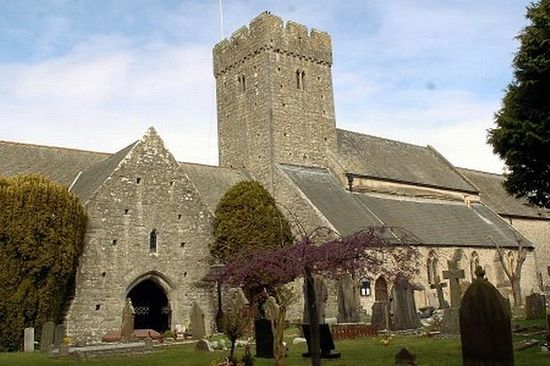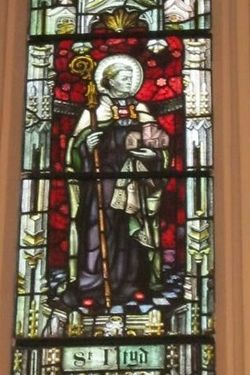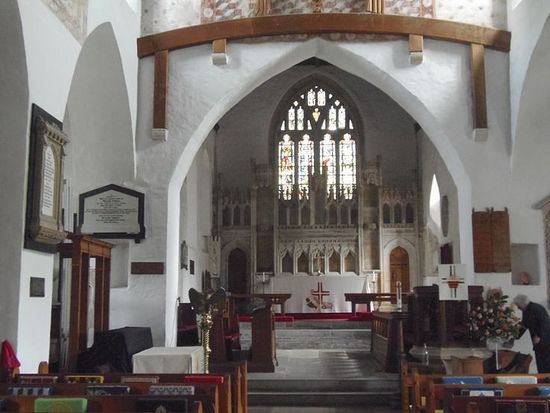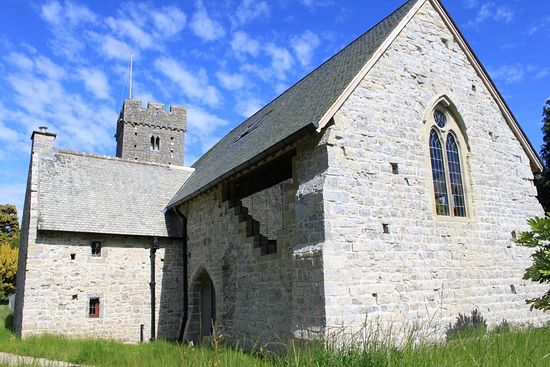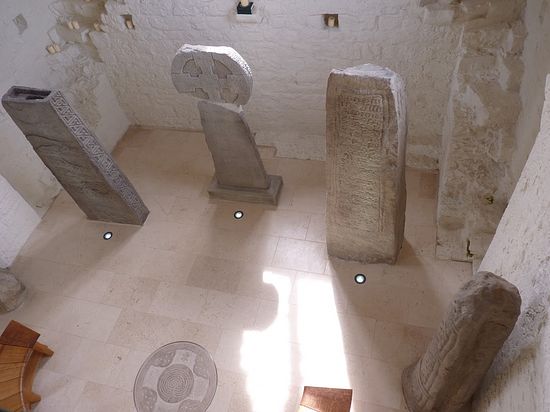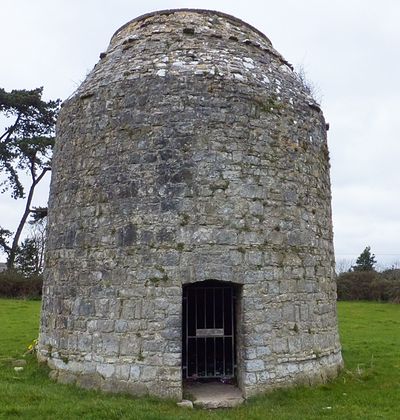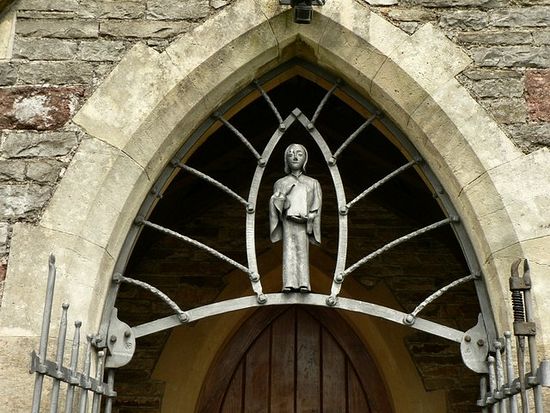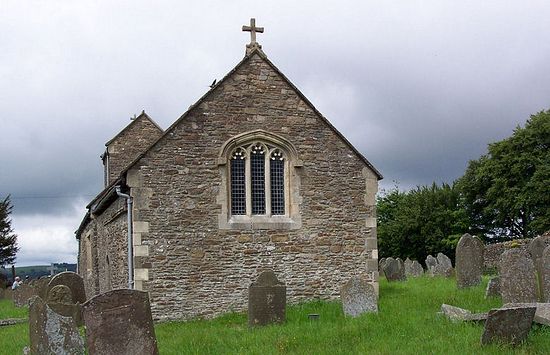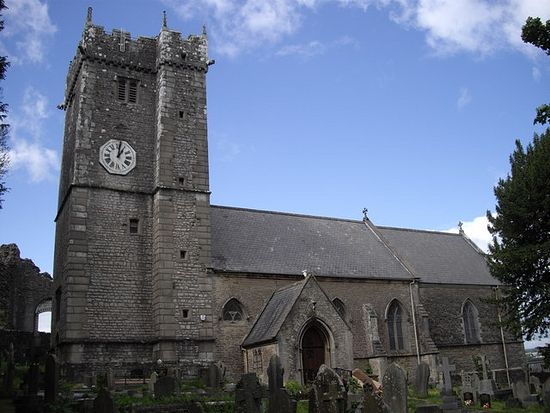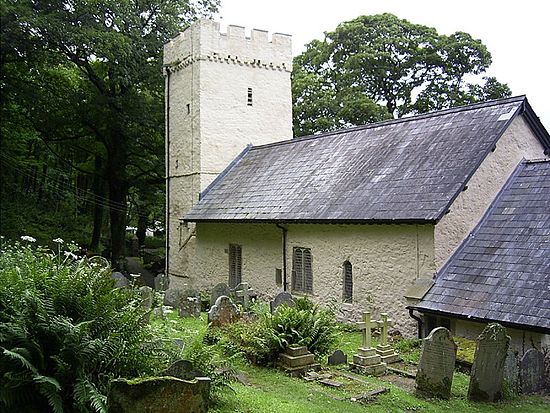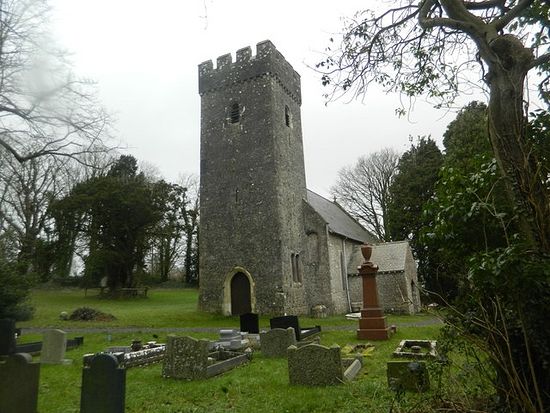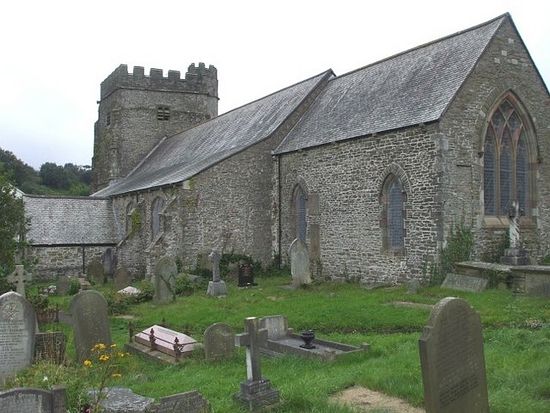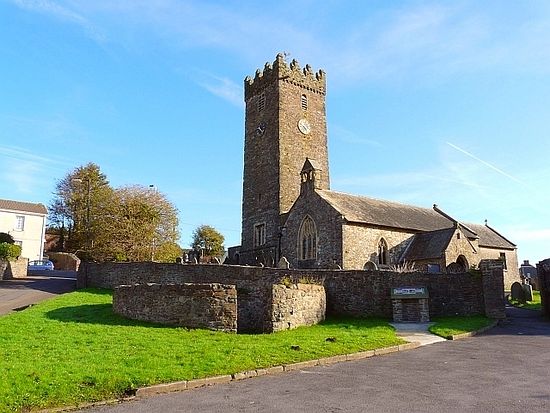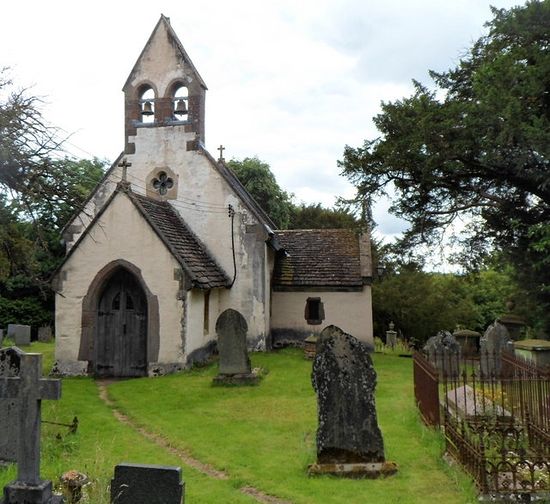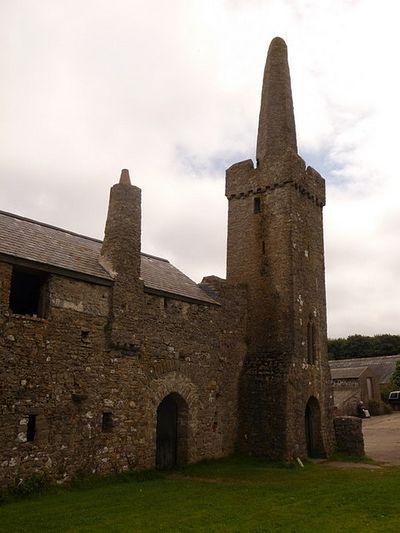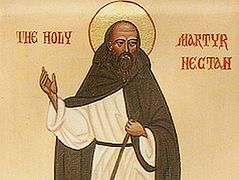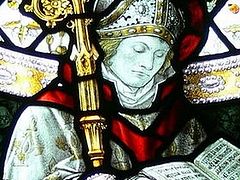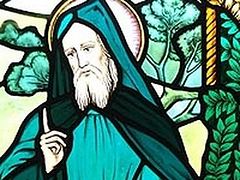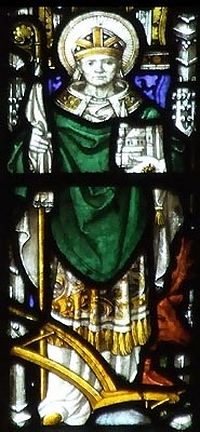 A stained glass of St. Illtyd
A stained glass of St. Illtyd
Though Wales was never occupied by the Germanic barbarians, the still pagan Irish did make frequent raids on its lands in the same fifth century. As a result of the spiritual vacuum, such heresiarchs as Pelagius appeared in the first half of the century. The great and talented hierarch from Gaul, St. Germanus of Auxerre (feast: July 31/August 13), undertook two very successful missions to Britain—in 429 and 447—and, assisted by two other saintly clerics, defeated this heresy in Albion. Soon after, strong Orthodox monastic traditions reached Wales and from there Cornwall and Ireland. These influences came from Egypt, mainly via Gaul and northern Spain. Thus Orthodoxy was revitalized in all of these regions for many years. The Celts adopted these ascetic traditions so wholeheartedly that from the fifth to the seventh century these lands were called “a Thebaid of Saints”. Here the early influence of St. Germanus of Auxerre is truly significant, for not only did he erase Pelagianism in Britain, but he also became the teacher of one of the greatest Welsh saints who, together with his disciples, spread Orthodox monasticism all over Wales. This saint’s name is Illtyd (better known as Illtud, and also Eltut). Let us now recall his life.
St. Illtyd, who knew very well both the Old and New Testaments, all kinds of philosophy, and other sciences, and was one of the most learned figures of his age, was probably born in the first half of the fifth century. His father’s name was Bicanus, and mother’s name—Rieingulid. According to one version, he was the son of a Breton princess and a noble soldier, but according to another, more reliable tradition—his birthplace was Glamorgan in south Wales. Though Illtyd is one of the most venerated saints of Wales throughout its history, few genuine facts about his life survive. The earliest written evidence of him can be found in the life of St. Samson of Dol, one of his spiritual children, and this was composed in c. 600 AD. There is also a medieval life of Illtyd, written in the twelfth century, though it is not a trustworthy source.
In his youth the future saint obtained a brilliant education. His parents wished to dedicate their son to literature—it was said that he had an excellent memory and was very eloquent from a very early age. He chose a military career in his youth, becoming a soldier (according to medieval sources). It is also known that before taking up monasticism, Illtyd was married to a very pious woman called Trynihid. After some years in happy marriage, the couple, following a miraculous event, decided to separate and dedicate the rest of their lives to the service of the Lord. Illtyd’s wife probably became an anchoress in the Welsh mountains and lived in holiness, establishing a nunnery and an refuge for women, while her holy husband became one of the founding fathers of Welsh monasticism. St. Illtyd is referred to in many sources as a disciple of St. Germanus of Auxerre (possibly a distant relative), who instructed and trained him either during one of his two visits to Britain or (which is less probable) in Gaul, where Illtyd came to gain experience in monastic life. St. Illtyd later became a monk and was ordained to the priesthood by Germanus, together with a number of other future saints. In the following years he founded many churches, monasteries and schools in Wales, the most famous of which was the monastery in Llantwit, named Llanilltud Fawr in Welsh, or Llantwit Major in English, literally meaning “the great church of Illtud”.
It was an angel who more than once directed Illtyd to the location of this monastery—in a beautiful wooded valley. The monastery was situated in Glamorgan in the south-east of Wales and today it is in the Vale of Glamorgan county borough. Illtyd became the first abbot of the monastery and ruled it for many years. Most of the saints of that period came from it. Hundreds of monks lived in Llantwit Major simultaneously and one early source says that at various points altogether some 3,000 brethren led the ascetic life there under the holy abbot Illtyd. Monastic life in this great center flourished until the Norman Conquest, and it gained fame for teaching Greek, Latin, theology, philosophy, grammar, poetry, rhetoric and mathematics. Indeed, it was one of the finest educational centers in Western Europe at that time and possibly the first center on such a scale in Britain. At the monastic church under St. Illtyd prayer never ceased—100 monks prayed and held vigil inside the church day and night.
St. Illtyd was venerated in his lifetime as a great wonderworker on whom the Lord also bestowed the ability to foresee future events. As was the case with many other Celtic saints who imitated the Egyptian, Syrian and Palestinian desert fathers, Illtyd led a severe ascetic life. It was recorded that the man of God used to go deep into cold water at night and to repeat the Lord’s Prayer there till the morning. As his life reads, the holy abbot of Llantwit devoted his time to manual work, fasting, abstinence, watching, kneeling and praying. He fed the hungry, clothed the naked, healed the sick and visited prisoners. He was filled with hospitality, compassion and humility, and he had no pride in spite of his numerous talents. It was said that solitude was dear to his heart and he spent almost three years absolutely alone in a secluded cave in prayer.
Among the disciples of St. Illtyd we can mention such illustrious early Church Fathers of Wales as St. David of Mynyw, St. Samson of Dol, St. Gildas the Wise, St. Tudwal, St. Paul Aurelian, and St. Maglorius. Many of his disciples later moved to enlighten Brittany and other Celtic regions like Devon and Cornwall. The great abbot-bishop St. Deiniol of Bangor can also be regarded as one of his disciples. A large number of spiritual children of Illtyd were to become celebrated teachers and missionaries. A multitude of young men from all over Wales, south-west England, Brittany and other regions of France, flocked to his monastery to study and live a holy life, with several princes among them. According to some sources (though it is not always chronologically correct), among close friends and spiritual companions, or perhaps rather spiritual descendants, of this great saint of God were such important figures as St. Cadoc (with whom Illtyd led the ascetic life in seclusion for some time) and Dyfryg (Dubricius). The noted bard of that era, named Taliesin, reputedly went there as well.
The Life of St. Samson, mentioned above, describes St. Illtyd as “the most prominent teacher of the Britons and of the whole of Britain.” This is a very important testimony and indeed the influence of this saint greatly contributed to the formation of monastic life, culture, education and learning in the Wales of that era. St. Illtyd closely communicated with wild animals. Thus, once he rescued a stag from King Meirchion who was hunting it. This stag became tame and even delivered timber for the saint on a cart in order to build his church. According to one version, Illtyd reposed in Brittany where he had sent ships with corn in order to support the local population suffering from famine. However, the Welsh tradition claims he reposed in Wales, in his main Llantwit Monastery. Whatever the truth is, the saint had numerous disciples not only in Wales, but also in Brittany. The year of his death is sadly unknown: researchers suggest the early sixth century (either c. 505 or c. 530) as the time of his demise. The saint has been venerated on November 6/19 since then—the day of his departure to the Lord.
Countless churches, chapels, settlements and other objects across Wales were named in honor of Illtyd after his death. He was highly esteemed as one of the leading figures of the early Church in Wales. There was a bell reputedly belonging to St. Illtyd (given to him by St. David) which for some centuries was venerated as a separate relic. It was related how St. Illtyd miraculously saved Glamorgan people during the reign of William the Conqueror from death at the hands of the people of Hen Ogledd (the Old North). The abbey and school founded by the saint were first attacked by the Vikings in the late 10th century, later functioned as a collegiate church and then as a community attached to Tewkesbury Abbey in Gloucestershire (England) until the Reformation.
Today the site of the St. Illtyd’s former monastery is called Llantwit Major. It is a small coastal town in the Vale of Glamorgan near the Bristol Channel. The site of the monastery is marked by the 13th-century church of St. Illtyd, which stands approximately on the site of the monastery church. This is one of the most ancient and important churches in all Wales. This church contains a large collection of historic wall-paintings and sculptures of saints, abbots and kings (dating from the pre-medieval and medieval periods). Today this is once again a destination for pilgrimages and not long ago it underwent large-scale restoration work. The church is divided into two parts: the west (Norman) and the east (later, 13th-century) churches. The western half in the past served the spiritual needs of the townspeople while the eastern half was the monastic church till the Dissolution. After the Reformation the eastern part of the church was permanently used as a parish church, while the western part slowly fell into disrepair.
Today the eastern part, where the most services are held, houses numerous frescoes, sculptures, squints (oblique openings through a wall in church permitting a view of the altar from an aisle or side chapel), a fine carved reredos and other artefacts, while the recently restored Galilee chapel contains a huge collection of the local “standing” stones and Celtic crosses, many of which are inscribed. The eastern and western parts are separated from each other by a wall. The western part was restored in the early 20th century, some services are still celebrated there and it has a collection of clerical effigies. Today’s Galilee chapel is the former medieval chantry chapel previously attached to the western part of the church—it fell into ruin in the centuries following the Reformation and it was decided to restore it only a few years ago. The solemn opening and consecration of the splendidly restored two-storied Galilee Chapel with the visitors’ center and research hall took place in November 2013 with the participation of the Archbishop of Wales and many prominent guests.
The crosses displayed in the Galilee Chapel date from the ninth and tenth centuries and are diverse in shape and decoration. Perhaps the earliest relic among these is the sixth-or seventh-century “Samson’s stone” containing an inscription from the hand of St. Samson of Dol and this inscription mentions St. Illtyd. Previously most of these crosses and stones had been housed either in the western part of the church, the churchyard or even private gardens. Interestingly, it was decided to refurbish the Galilee chapel in such way that all the previously ruined fabrics and details be retained and the new fabric only slightly affect them. The chapel now also displays the history of Christianity in Llantwit Major throughout the centuries. Indeed few churches in Wales can offer such a wide range of monuments, artefacts and history as Llantwit Major. When the co-founder of Methodism, John Wesley (1703-1791), visited this church in 1777, he remarked that it was the most beautiful church in the country. In July 2014 the Prince of Wales and the Duchess of Cornwall made a royal visit to the Galilee Chapel in Llantwit. Now ecclesiastic figures, lecturers, researchers and simple faithful come to this church. Only minor ruins survive of the former Llantwit school—they can be traced in the grounds near the churchyard. From the monastic secular buildings a monks’ dovecote (fourteenth century) and a gatehouse substantially survive.
Many other Welsh churches are dedicated to St. Illtyd. Thus, he is the patron of one of churches within the town of Pontypridd in the county borough of Rhondda Cynon Taf (Mid Glamorgan), its exact location is the large village called “Church Village”. Another St. Illtyd’s Church in this county can also be found in the village of Llanharry (dating from the nineteenth century). The ancient church in the village of Llanhilleth in the area Blaenau Gwent is dedicated to St. Illtyd, but its first patroness was St. Heledd. This is the oldest church building in the county, but the church is currently unused, though it was miraculously saved from demolition in the twentieth century and is still open to the public. Its churchyard has part of an early “preaching cross”—such crosses were erected by Celtic missionaries. Next to this village there is the hamlet of St. Illtyd which derived its name from our saint. Another very old church in honor of St. Illtyd can be found on the top of the hill called Newcastle Hill in Newcastle, in Bridgend county borough. The quiet church overlooks the town and stands in a lovely setting on the bank of the River Ogmore. Its first patron was St. Leonard. The church was largely rebuilt in the nineteenth century.
Another very interesting church that bears name of this saint is situated in a picturesque wooded site on the Gower peninsula. The exact place is called Oxwich and the church stands over Oxwich Bay in West Glamorgan. The first church on this site was built in the sixth century. It was said that St. Illtyd himself erected a small cell here and brought here a stone font and the local people believe that the current church font is precisely that same font. The little church was rebuilt in the thirteenth century and is active to this day. Traditions and legends associated with St. Illtyd in Gower Peninsula abound. The village of Ilston near Oxwich is named after St. Illtyd. The local thirteenth-century church bears his name as well. It stands where the sixth-century cell once occupied by the saint itself stood. Significantly, that cell was incorporated into the church tower built above it, serving as its base. Recently the former cell was restored as a chapel.
There is a unique church dedicated to Sts. Illtyd and Rhydian in the village of Llanrhidian in Gower. The church is of the fourteenth century, and there are a holy well, remains of a ninth- century “leper stone” along with a wheeled 11th-century cross shaft near it. The holy well of St. Illtyd is also known as the “milk well”, because in the twelfth century many residents witnessed how milk flowed in it instead of water. According to tradition, St. Illtyd lived in this spot as hermit. But the sea often flooded the territory, destroying the saint’s cell and chapel. Several times he built an embankment of mud and stones to protect himself, but in vain. He asked an angel to help him and the sea obeyed the saint, subsiding. On this dry shore he then struck his crozier to the earth and a holy well gushed forth immediately. This very well exists there to this day and has curative properties.
The village of Llantrithyd lies in the Vale of Glamorgan not far from Cowbridge. Its name is connected with St. Illtyd and its pretty fifteenth-century church is dedicated to him. There is an interesting small town in Rhondda Cynon Taf called Llantrisant whose name means “of three saints”. This town, together with its main Anglican church (Church of Wales), since time immemorial has had three holy patrons: Sts. Illtyd, Gwynno, and Dyfodwg. Prayer has continued in this place for more than 1300 years, and the present church was rebuilt in the mid-thirteenth century. One of its stained glass windows depicts a crucifixion with a beardless Christ, which is a very rare feature. The church also has a very early seventh-century stone with three ancient crosses.
We should also mention the outstanding Norman (and partly pre-Norman) church of St. Illtyd in the town of Neath, on the river with the same name in the Neath Port Talbot area. The settlement and church were first founded by the saint himself and called Llantwit Minor, and the local parish is still called “Llantwit”. A medieval Church of Sts. Illtyd and Peter is located in the village of Llanhamlach in the rural part of Powys, on the river Usk. The large village of Pembrey in the county of Carmarthenshire has a church dedicated to our saint as well.
The holy island of Caldey near the Welsh Pembrokeshire coast has a recently restored thirteenth-century church of St. Illtyd with a “leaning tower” and many other buildings of the medieval priory that was dedicated to the Mother of God and St. Illtyd. Apart from the almost complete priory and the mentioned church, there is also St. David’s Anglican Church on the island. Many early hermits lived in this island in the age of saints, especially St. Samson, the disciple of St. Illtyd, and Abbot Pyro. Notably, there has been a Catholic Cistercian (Trappist) Abbey on Caldey since 1929, making Caldey along with Iona and Lindisfarne, a place with a continuity of the monastic tradition in spite of many years of desolation. Today Caldey is visited by pilgrims. There is a thirteenth-century church of St. Illtyd (founded in the sixth century) overlooking the town of Abertillery in Blaenau Gwent. The tiny village of Mamhilad in Monmouthshire boasts a little medieval church in memory of our saint, and in the churchyard grows a yew-tree which, they say, is about 2,500 years old. There is a Roman Catholic church dedicated to St. Illtyd in the Dowlais parish in the Merthyr Tydfil area.
Most of these churches are concentrated in south or southeastern Wales. One of the very few ancient places dedicated to Illtyd outside the southern districts of Wales is Llanelltyd in Gwynedd in north-west Wales, where there is a twelfth-century St. Illtyd’s church near the ruins of Cymer Abbey. A 103-kilometer-long route known as “St. Illtyd’s Walk” exists in South Wales in memory of Illtyd. This saint is also venerated in Brittany where he is commemorated by many churches and place names.
Holy Father Illtyd of Wales, pray to God for us!

